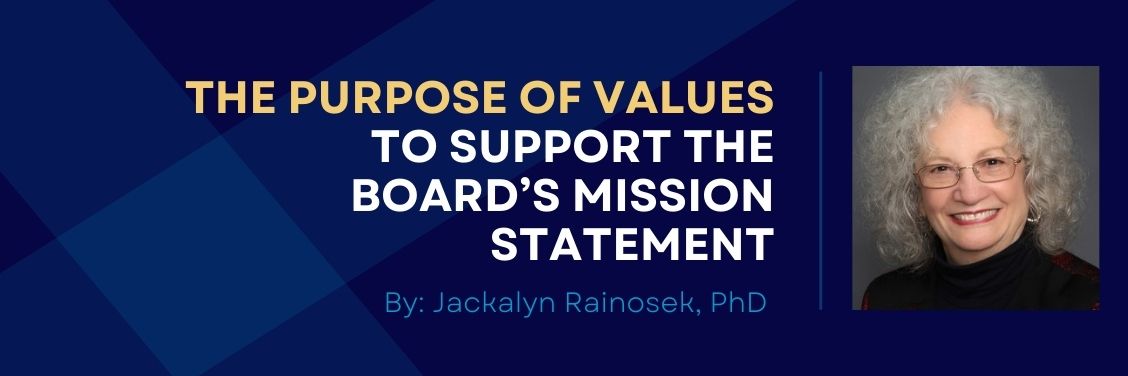The Purpose of Values to Support the Board's Mission Statement

Questions to Ask in the Boardroom
- What are five values that are defined and utilized to support the board’s mission?
- How do board members identify their actions and behavior in the board meetings that show appreciation for the board values?
Taking the Next Step
I have another exercise I do with boards that continues the process of bringing members together by helping them to coalesce around a common set of values. These board values are based on board members first identifying their five most important personal values and then identifying a set of shared values from everyone’s personal values meant to guide the actions of the board.
I am currently president of a non-profit board with the mission to raise funds in support of educational scholarships for young women. Established in 1980, the board has had only white women as members despite the racial diversity of the students receiving scholarships. However, this began to change in 2020 with my tenure as president, when I added two Black women to the board. In December of 2021, I had the board members complete an exercise wherein they identified their own five most important values, and each member then shared her personal values with the rest of the board at the December board meeting. The discussion was lively and fun, and the members learned a great deal about one another.
In the January 2022 board meeting, the board took the five personal values from each of the 12 members and went through a process of paring this list down to establish five shared values for the board itself. I told the members that the purpose of these values is to establish the behaviors and attitudes of the board and to support the mission of the organization. Like the December meeting, the discussion was lively, respectful, meaningful, and each member was excited about how she could use the five values to support her specific roles and contributions. Here are the mission statement and values that the board created:
Mission:
The mission of the Foundation is to award scholarships and gifts to aid and advance the education and knowledge of women in the community.
Values:
- Education: Promoting programs, grants, and scholarships
- Diversity: Inclusion and supporting equity
- Integrity: Truthful and honest interactions
- Service: Promoting growth through action
- Creativity: Innovation and fun
Since the conclusion of this exercise, significant changes are beginning to emerge on the board. Every member is looking for ways to see how race, gender, LGBTQ, and other differences enhance the board’s decision-making process. A male is now serving as a board member for the first time. Three members of the board are members of the LGBTQ community, another member is ethnic Chinese, and two members are Hispanic. Members of the board now comment about the richness that comes from having a diversity of ideas and viewpoints, and they describe how much fun they are having as members and that they look forward to board meetings and fund-raising events. There is even new creativity and energy emerging in the ideas and discussions about fund raising, and the board will continue to become more diverse as positions become available.
There is a heart to this board that did not exist previously. This is the result of exercises like identifying values and storytelling. I have also helped by introducing more information about DEI, providing tools like a Leadership Guide, and facilitating more productive conversations among board members. (The values exercise is available on the DTP Leadership Group website by going to www.dtp-leadership.com/dtp-articles and selecting the link Values with Exercise 6-1-15.)
Suggestions Before Using the Values Exercise
I recommend that the board chair and co-chair go through the values exercise and identify their own five values. Second, I encourage the chairs to have a discussion with each other to see if their values support diversity, equity, and inclusion. It is critical that each person is clear about how their individual values and definitions of those values connect to their respective board positions as well as the vision and mission of the board. After completing the values exercise, each person determines how they would share their story about their growing up years and personal and professional development that has led to their interest in and commitment to diversifying the board membership. To assist you, I have provided an example of how I can share my values and connect them to my support for diversity, equity, and inclusion. I hope this will help you understand the power and possibilities available in connecting to your own values and the understanding of the self that is required.
Over the years, I have identified five values that are at the core of my being. They are Honesty, Risk-taking, Service, Spirituality, and Diversity. I make every effort to live these five values daily, since they support my purpose in life, which is to be real and live in truth.
My desire is for every board to become a learning community that appreciates differences and sees them as strengths. This view then supports the board to be innovative and creative in every aspect of its work. In these conditions, differences will assist board members in finding unique and valuable solutions and they will learn to heighten their awareness of and utilization of diversity.
Diversity also requires the encouragement of risk-taking since change does not occur without risk. Risking by accepting an unfamiliar perspective or a way of doing things leads to new ways of making decisions, acting, and being. The inclusion of the first-ever male member on the Foundation board I mentioned earlier came about because a member was willing to take the risk to point out that there is nothing in the bylaws to prevent males from serving on the board.
Honesty supports interactions and relationships that are genuine, sincere, and clear. Knowing that board members adhere to honest interactions increases trust among members. When members trust each other, they become more willing to expand their thought patterns related to diversity, equity, and inclusion.
Service becomes the foundation for being a board member. Members become invested in one another, and they focus on making a difference in the environment of the organization that the board serves. Service can be achieved most effectively with the spiritual principles that are the foundation of my beliefs, attitudes, and behaviors.
Conclusion
Any board can utilize storytelling and the values exercise to foster an open discussion of what is important to each individual board member and what is important to the board as a whole. As the members come to know more about each other, then discussions that come later about DEI topics will be constructive and lead to a productive way of diversifying a board’s membership.
More Questions for Board Members to Consider
1. What did the board members learn from the process of establishing five values for the non-profit board described in this article?
2. How can the board members utilize these learnings to create more openness and discussion about diversifying the board?
3. When the chair and vice chair discuss their own values, how will that help them to facilitate the value exercise?
4. What would encourage board members to go through the process of the value exercise?

ABOUT JACKALYN RAINOSEK, PHD
Dr. Jackalyn Rainosek is CEO and Co-Founder of DTP Leadership Group, as well as founder and principal of DTP Business Strategies. She has worked extensively with a wide range of Leaders as they make strategic decisions in ever-changing circumstances to achieve extraordinary results and increase profitability. As a senior business consultant and marketing strategist Dr. Rainosek works with business owners and corporate executives to generate optimal results and exponential growth. Dr. Rainosek guides organizations to develop more appropriate leadership styles, enhance cultural competency (through diversity, equity, and inclusion initiatives), and improve levels of trust and cooperation both internally and with the customer base.

